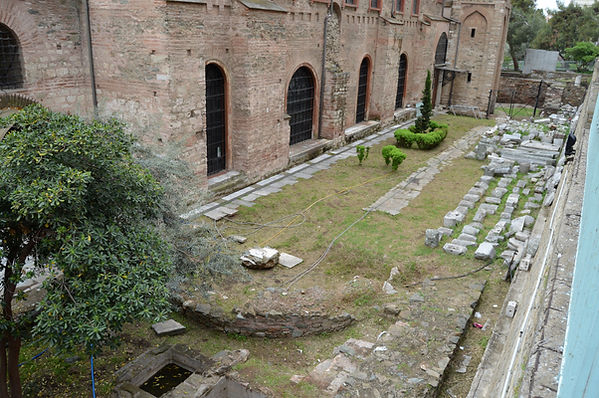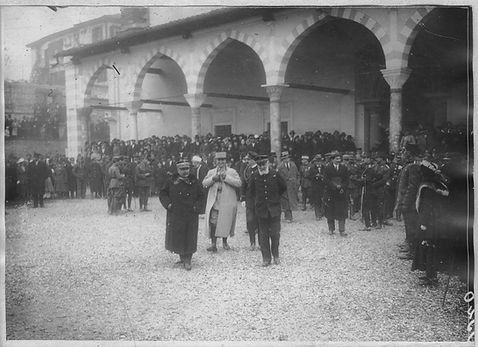Hagia Sophia, the Great Church, which served as the metropolitan church of Thessaloniki throughout much of its history, was constructed on the remains of the large, five-aisled episcopal Basilica of Saint Mark following its destruction in the early 7th century. Although the church is now freestanding at the center of a city block, in the Middle Ages it was surrounded by buildings, including the putative remains of the medieval episcopal residence to the north. Scholars have dated the building anywhere from the mid-6th to the mid-8th century. Based on comparative studies of its architecture and deco-ration, the building was probably erected during the third quarter of the 8th century, that is, at the end of the First Iconoclastic period. In its pres-ent form, the church is a concrete cubic structure that is almost square in plan. A tripartite sanctuary projects from the eastern end. The interior of the church has a square cruciform nave that measures around 31x 29 m without the apse. The nave is covered by a large dome that is supported by four barrel vaults of unequal length and slightly different heights (14.75–15.00 m). Lateral aisles and a narthex surround the nave, forming an ambulatory, with three galleries above them. These galleries are earlier in date than the west gallery, which was added in the 10th century. Excavations in the north and west galleries revealed building debris and amphoras that were used to raise the floor level without exerting too much weight on the domed support structures of the ambulatory. The discovery of numerous lead seals with the names of bishops and other ecclesiastical officials in the southwest corner of the west gallery indicates that this space was used for church administration.
Of the superstructure, only the large cubic drum of the dome, pierced by 12 arched windows, projects above the post-Byzantine timber roof. This dome replaced an earlier one that seems to have collapsed during the earthquakes of 813–820. The most interesting features of the church include the nearly perfect square of the central space and the articulation of the structural system that supports the large dome overhead. The wide barrel vaults spring from four massive piers at the corners of the central space, which are themselves divided into sections by arches that are larger on the ground level while smaller and doubled above. These piers are emphasized by prominent cornices on two levels, with the upper cornices marking the springing of the pendentives below the dome. Small corner bays are formed within these complex piers. The area beneath the dome is unified spatially with the areas covered by the transverse arms of the cross, while the east arm opens into the sanctuary and extends slightly along the east–west axis through an additional, deeper barrel vault overhead, giving the impression of visual continuity while accentuating the height and importance of the central apse. The lateral aisles, divided from the central nave by colonnades that alternate columns and narrow piers, are covered by barrel vaults. The inner narthex, by contrast, features a variety of vaulting solutions, including groin, sail, and shallow calotte vaults.
Art of Hagia Sophia
COMING SOON
Apse mosaic with Theotokos and Christ Child
Inscription from semidome arch from Psalm 64:5
†Πλησθησόμεθα ἐν τοῖς ἀγαθοῖς τοῦ οἴκου σου, αγιος ὁ ναός σου, θαυμαστὸς εν δικαιοσύνῃ.
“We shall be filled with the good things of thy house, thy temple is holy, [Thou art] wonderful in righteousness.”
Dome mosaic of the Ascension
Inscription from Acts 1:11
Ἄνδρες Γαλιλαῖοι, τί ἑστήκατε βλέποντες εἰς τὸν οὐρανόν; οὗτος ὁ Ἰησοῦς ὁ ἀναλημφθεὶς ἀφ’ ὑμῶν εἰς τὸν οὐρανὸν οὕτως ἐλεύσεται ὃν τρόπον ἐθεάσασθε αὐτὸν πορευόμενον εἰς τὸν οὐρανόν.
Ye men of Galilee, why stand ye gazing up into heaven? this same Jesus, which is taken up from you into heaven, shall so come in like manner as ye have seen him go into heaven.
Virgin Mary and Saints from the Ascension
Frescoes of saints from the narthex
Capitals
Hagiasma of Hagios Ioannis, probably originally a baptistery dating to the 5th century

Plan of basilica ruins under Hagia Sophia from Ćurčić

Plan from Ćurčić
Drawing from Texier (1864)


Normand & Mézières (1851)






Homolle (1915)
Frédéric Gadmer (1915)
Homolle (1915)
Gaston Chérau (1915)
Gaston Chérau (1915)
René Prouho (1915-1916)
Charles-René Darrieux (1916)
Paul Dubray (1917)
Paul Dubray (1918)
Paul Dubray (1918)
Paul Dubray (1918)
Paul Dubray (1918)
Charles Martel (1918)

Plan from Theocharidou
Icon of Christ Pantokrator (late 14th century)
From Hagia Sophia, Thessaloniki
At the Museum of Byzantine Culture Thessaloniki

Ambo at Istanbul Archaeological Museum
Reportedly from Hagia Sophia in Thessaloniki
Photo from Schultz and Barnsley
Twin slab with crosses in discs from the Church of Hagia Sophia, Thessaloniki (5th-6th century)
It was reused and remnants of the paint film from this period are still visible
At the Museum of Byzantine Culture in Thessaloniki
Ceramics from the north gallery of Hagia Sophia in Thessaloniki (7th-8th century)
At the Museum of Byzantine Culture in Thessaloniki
Sepulchral monument from Hagia Sophia of Thessaloniki (after 1224)
At the Museum of Byzantine Culture in Thessaloniki
Source
Byzantine Architecture by Cyril Mango
Architecture in the Balkans from Diocletian to Süleyman the Magnificent by Slobodan Ćurčić
Early Christian and Byzantine Architecture by Richard Krautheimer
Wandering in Byzantine Thessaloniki by Tourta and Kourkoutidou-Nikolaidou
Oxford Dictionary of Byzantium edited by Alexander Kazhdan
Resource
Hagia Sophia Thessaloniki Album (Byzantine Legacy Flickr)
Hagia Sophia (Religious Greece)
Icon of Christ Pantokrator (Museum of Byzantine Culture Thessaloniki)
.jpg)
.jpg)
.jpg)
.jpg)
.jpg)
.jpg)
.jpg)
.jpg)
.jpg)
.jpg)
.jpg)
.jpg)
.jpg)
.jpg)
.jpg)
.jpg)
.jpg)
.jpg)
.jpg)
.jpg)






















